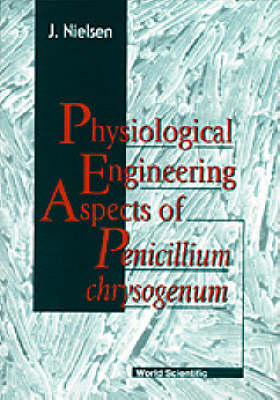
Physiological Engineering Aspects Of Penicillium Chrysogenum
Seiten
1997
World Scientific Publishing Co Pte Ltd (Verlag)
978-981-02-2765-4 (ISBN)
World Scientific Publishing Co Pte Ltd (Verlag)
978-981-02-2765-4 (ISBN)
- Titel z.Zt. nicht lieferbar
- Versandkostenfrei
- Auch auf Rechnung
- Artikel merken
This work offers a review of penicillin production by "Penicillin chrysogenum", and also deals with a number of general aspects of fungal cultivations, eg. primary metabolism of filamentous fungi, morphology, monitoring of fungal cultivations, and bioreactor performance.
The book gives a review of penicillin production by Penicillium chrysogenum, and also deals with a number of general aspects of fungal cultivations, e.g. primary metabolism of filamentous fungi, morphology, monitoring of fungal cultivations, and bioreactor performance (more than 750 references).The first two chapters give an introduction to the area of penicillin production; with a review of the history and a survey of the present status of this industrially very important process in the first chapter. In the second chapter is given an introduction to the microorganism, i.e. its nutritional requirements, its taxonomy, and an overview of different strain development programmes.Chapter 3 gives an introduction to the concept of Physiological Engineering. This is followed by a review of various monitoring techniques and different theoretical techniques for analysis of cultivation processes, e.g. mathematic modeling, metabolic flux analysis, and metabolic control analysis.Chapter 4 and 5 give a review of the metabolism, with the primary metabolism being the topic of Chapter 4 and the secondary metabolism, i.e. penicillin biosynthesis, being the topic of Chapter 5. The review of the penicillin biosynthetic pathway is followed by a description of a number of results obtained using metabolic flux and metabolic control analysis.Chapter 6 is devoted to the morphology of the fungus, and it gives a detailed description of the growth mechanisms of filamentous fungi.Chapter 7 deals with the bioreactor performance during fungal cultivations, i.e. medium rheology, gas-liquid mass transfer, and mixing.Finally is the fed-batch process applied for penicillin production described in Chapter 8. It gives an overview of the most important factors influencing penicillin production.
The book gives a review of penicillin production by Penicillium chrysogenum, and also deals with a number of general aspects of fungal cultivations, e.g. primary metabolism of filamentous fungi, morphology, monitoring of fungal cultivations, and bioreactor performance (more than 750 references).The first two chapters give an introduction to the area of penicillin production; with a review of the history and a survey of the present status of this industrially very important process in the first chapter. In the second chapter is given an introduction to the microorganism, i.e. its nutritional requirements, its taxonomy, and an overview of different strain development programmes.Chapter 3 gives an introduction to the concept of Physiological Engineering. This is followed by a review of various monitoring techniques and different theoretical techniques for analysis of cultivation processes, e.g. mathematic modeling, metabolic flux analysis, and metabolic control analysis.Chapter 4 and 5 give a review of the metabolism, with the primary metabolism being the topic of Chapter 4 and the secondary metabolism, i.e. penicillin biosynthesis, being the topic of Chapter 5. The review of the penicillin biosynthetic pathway is followed by a description of a number of results obtained using metabolic flux and metabolic control analysis.Chapter 6 is devoted to the morphology of the fungus, and it gives a detailed description of the growth mechanisms of filamentous fungi.Chapter 7 deals with the bioreactor performance during fungal cultivations, i.e. medium rheology, gas-liquid mass transfer, and mixing.Finally is the fed-batch process applied for penicillin production described in Chapter 8. It gives an overview of the most important factors influencing penicillin production.
| Erscheint lt. Verlag | 3.5.1997 |
|---|---|
| Verlagsort | Singapore |
| Sprache | englisch |
| Themenwelt | Naturwissenschaften ► Biologie ► Biochemie |
| Naturwissenschaften ► Biologie ► Mikrobiologie / Immunologie | |
| Naturwissenschaften ► Biologie ► Mykologie | |
| ISBN-10 | 981-02-2765-5 / 9810227655 |
| ISBN-13 | 978-981-02-2765-4 / 9789810227654 |
| Zustand | Neuware |
| Haben Sie eine Frage zum Produkt? |
Mehr entdecken
aus dem Bereich
aus dem Bereich


